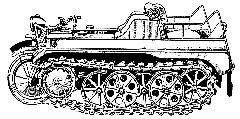

In October 1992 I bought my first Kettenkrad. To be more precise: I bought a modified hull and a pile of parts. After WW2 this Kettenkrad was used by a farmer in East Germany. He threw away all the parts, which he didn't need on the field: Battery- and toolbox, rear seat, bonnet, one of the two fuel tanks, the headlamp and some more. He also fitted another engine (OPEL 1,2 litre SV instead of the original OPEL 1,5 litre OHV) and replaced the original driver's seat by a kitchen chair. The front fork was replaced by the front fork of a ZÜNDAPP KS 750 motorbike.
And the farmer welded some iron to the hull, to fit a plough. With these "modifications" a MV collector from East Germany bought the Kettenkrad from the farmer in the 80s. He began to restore the vehicle, but it was hard to get parts for a Kettenkrad in the "German Democratic Republic".
In 1989 came the german reunion and I met this collector. I was looking for a Kettenkrad, but he didn't want to sell it. Some years later he wanted to sell, but I was not interested, because it was much too much work to restore it, because of the many missing original parts.
So I continued looking for a Kettenkrad. On the autojumble at Mannheim there was a man, who sold NOS track connecting bolts for the Kettenkrad. I was fascinated and bought a set of 80. On this autojumble there were two Kettenkrads for sale, both in a terrible state, but for a lot of money. So I decided to buy the Kettenkrad from the east German collector, because it was better than those at the Mannheim autojumble.
Two days after the autojumble we made the deal. I bought an empty hull and a pile of rusty parts. My wife was sceptic, but I told her that such a Kettenkrad is a good investment and the money is not lost...
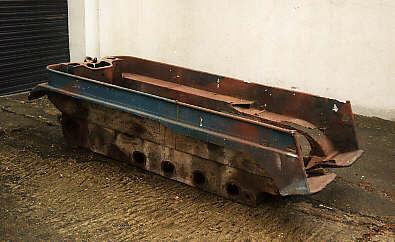 Completely
dismantled, with a lot of holes cut in. Some of them were cut
by the farmer, others by the former owner, when he cut away the iron,
which the farmer had welded to the hull to fit a plough. Completely
dismantled, with a lot of holes cut in. Some of them were cut
by the farmer, others by the former owner, when he cut away the iron,
which the farmer had welded to the hull to fit a plough. |
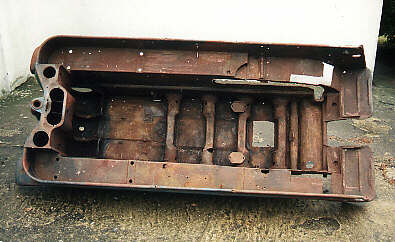 On
this picture you can see the lot of holes, which were in the hull. On
this picture you can see the lot of holes, which were in the hull.The complete area at the rear, where the towing hook was fitted, was missing. |
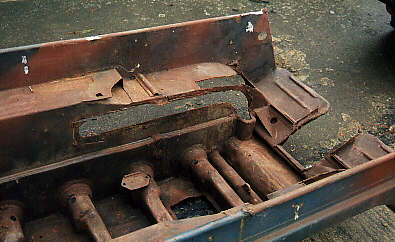 The
farmer had used an OPEL 1,2 litre SV engine. This engine has the exhaust
on the left side, the original engine on the right side. So the farmer
cut away the complete casing for the exhaust pipe on the right side
of the hull. The
farmer had used an OPEL 1,2 litre SV engine. This engine has the exhaust
on the left side, the original engine on the right side. So the farmer
cut away the complete casing for the exhaust pipe on the right side
of the hull.This was the most difficult thing to restore, because at first I didn't know how the casing had looked like. |
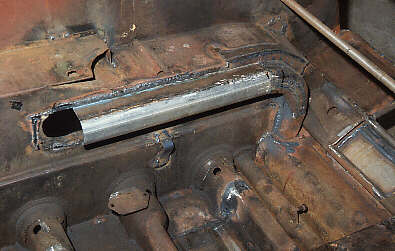 This
picture shows the casing for the exhaust pipe, as it looks today. This
picture shows the casing for the exhaust pipe, as it looks today.Also new made: The mounting for the radiator. |
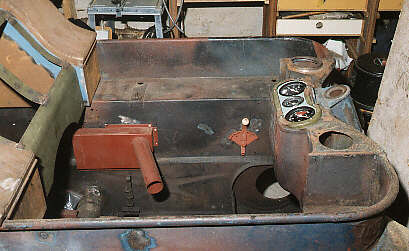 The
dashboard with the repro speedometer, tachometer and thermometer. The
dashboard with the repro speedometer, tachometer and thermometer.On the left wall the duct for the warm air from the radiator to keep the driver warm in Russia and the lever for the radiator flap. |
 View
from the front. New battery- and new toolbox, new bonnet. All these
parts are repro parts of poor quality. It took a lot of extra work,
until the repro parts were fitting. View
from the front. New battery- and new toolbox, new bonnet. All these
parts are repro parts of poor quality. It took a lot of extra work,
until the repro parts were fitting. |
 View from the rear. All parts except the hull are repro parts. Note the NOTEK blackout taillight in the middle. This part is an original N.O.S. part. It is the rare version with aluminium alloy housing. Later in the war aluminium was only used for aircraft, so parts for other vehicles were made from sheet metal or cast iron. |
This is the state of the Kettenkrad now (Mai 2000 and it still is in spring 2009!).
You see, it is still a lot of work to do.
During the last two years I had nearly
no time to work on the Kettenkrad. So I decided to
buy a second one, which is
in running condition.
So I bought Kettenkrad #2 in February 2000.